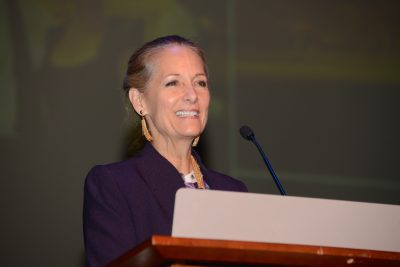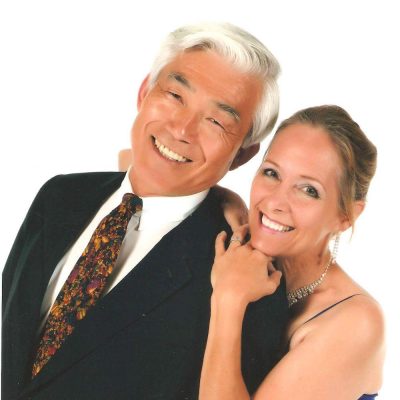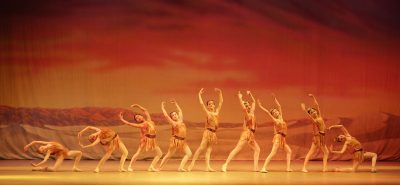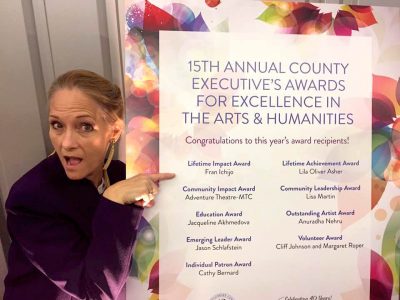At age 18, when most ballerinas were approaching their professional peaks, Fran Ichijo did her first tendu in a classical ballet setting. Once you hear the rest of her story, however, that becomes the kind of life fact that seems irrelevant.
Ichijo, who lives in Gaithersburg, went on to become an internationally known ballet star, and the dance company she helped develop in Korea has produced some of today’s finest dancers. Now she is shaping the next generation of dancers at Hope Garden Ballet Academy and Hope Garden Children’s Ballet Theatre in Poolesville, where she has continued to garner the support of the community and share her passion for the art that infuses all she does.

On Oct. 24, Ichijo was awarded the Lifetime Impact Award during the County Executive’s Awards for Excellence in the Arts and Humanities. The yearly event honors creators, facilitators and patrons of the arts. The Arts & Humanities Council of Montgomery County (AHCMC) facilitates the awards, but the selection process is coordinated by Montgomery County Executive Isiah Leggett and his wife Catherine Leggett. AHCMC Deputy Director Joe Frandoni said the awards showcase the importance of the creative economy highlighting the superb artistic and scholarly work being created and presented in Montgomery County.
There’s no shortage of quality ballet schools in the Washington, D.C. region, and Ichijo has become known in that community for her devotion to dance education. “It’s her lifetime commitment to excellence,” Frandoni said. “She has a huge passion for educating young people in dance.”
CultureSpotMC caught up with Ichijo at her studio prior to the ceremony. She said receiving the award was humbling. “There are two things I don’t do ballet for,” she said. “I don’t do it for money because no one ever starts a ballet school or company to make money—all they do is use money. I do it because I love it. I think it’s a great way to train children to become great adults.”

“I don’t really do it to get an award,” she added. “But it’s such a thrill for me because all the parents will believe in me even more.”
Ichijo spends most of her days at her studio. Sitting across the table from her in conversation or watching her vacuum the studio’s entryway—as she was wrapping up before this interview began—is just short of a quick study in épaulement. Ichijo is graceful and slender, with a long, fawn-like neck; her mannerisms are impossibly soft, yet deliberate. She can hit a 180-degree turn-out from first position in a moment’s notice—perfect positioning for ballet feet.
All this makes it hard to believe that she didn’t take her first classical ballet class until she was an 18-year-old college student. In the dance world, that is considered old. For context, Hope Garden Ballet Academy’s 11-year-old dancers are training six days a week. “Those formative years from 10 to 14 are the most important time,” she said. They’ve honed a sense of precision and grace, evident in basic things, like how they place their feet. As a practitioner of the Vaganova system, Ichijo expects dancers at this age to have perfect turnout (and they do, for the most part, she said)— the ability to form a straight horizontal line when they put their heels together. And they must maintain the turnout in one of ballet’s most common footings–fifth position, the formation of two parallel horizontal lines by placing the front heel directly front of the back foot’s toe. And that is just the feet.
Passion is what fueled Ichijo’s breakthrough. “So I played catch-up,” she said. “I took four classes a day.” She went on to earn a degree in dance and art at Hamilton College and continued performing, then trained in New York City and Monaco. By her early 20s, she was a full-on “dance gypsy,” auditioning in the Big Apple and in France.

All this paid off. Ichijo’s big break came at age 24, when she caught the attention of Adrienne Dellas Thornton, who was interested in taking a group of talented dancers to Korea. In the early 1980s, Madame Dellas, as Ichijo calls her, took her to Korea and went on to found the Universal Ballet Company in Seoul, where Ichijo was a founding member, soloist and instructor.
Posters of Ichijo’s former students and productions in Korea adorn her studio, and she still brags about her former students and how the dance company went on to produce some of the best dancers to hit the stage. Among them was Hee Seo, a principal dancer at American Ballet Theatre who trained at Universal Ballet Academy, the dance school associated with the company.
Spirituality is also an important aspect of Ichijo’s life. As members of the Unification Church, she and her husband Yoshi Ichijo were married in a mass ceremony in the 1980s. In 1994, they moved to a farm in Poolesville because, she said, the community was more suitable for their autistic son. She took a break from dancing when he was young. “When I was ready, I got back into teaching and was hired right away,” she said.

Ichijo launched Hope Garden Ballet Academy in 1997, starting off with three students. In five years, that number grew to 50. She has been at the Fisher Avenue location for the past five years and trains about 80 dancers. Hope Garden Children’s Ballet Theatre puts on a spring show and a holiday show each year. Posters of prior productions cover the studio walls — at least the portions that are not occupied by rows of elaborate costuming.
Even when empty, Ichijo’s studio makes visitors feel as if they are surrounded by love, and it’s clear the community knows this—they pitched in to help transform a former CVS into the bustling studio it has become.
But if you ask Ichijo, she says she is just doing what she loves. “I am a big believer in classical ballet and I don’t want it to ever die,” she said. “I’m on a mission to keep the art of classical ballet alive. I think it has so much to offer the world. You can communicate without spoken language—so it’s international.
“There’s nothing like a trained classical ballet dancer or a group of classical ballet dancers doing something together; there’s just nothing they can’t do.”